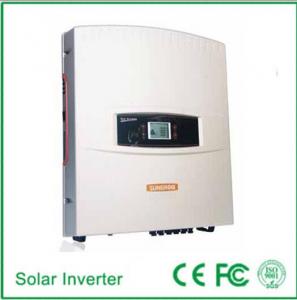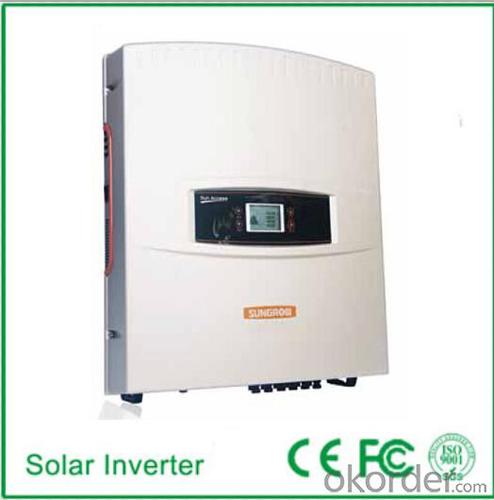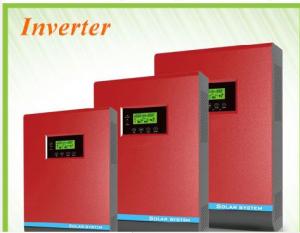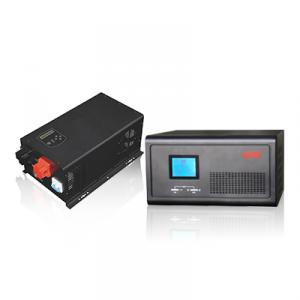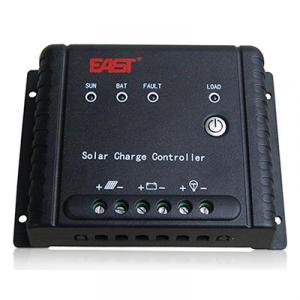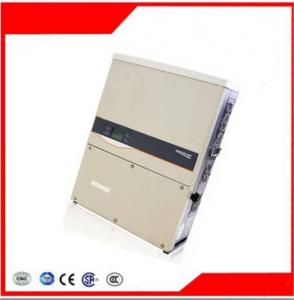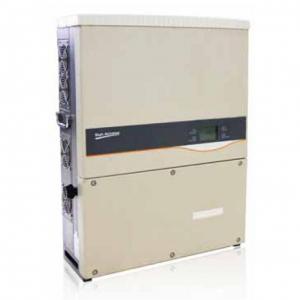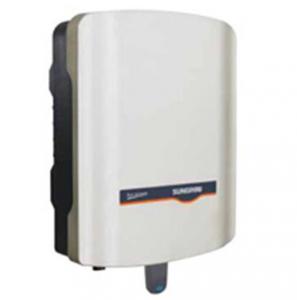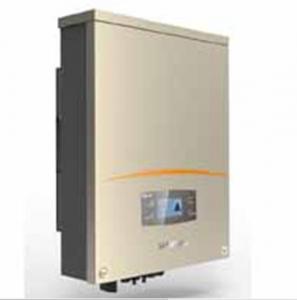Kaco Solar Inverter Photovoltaic On-Grid Connected Inverter SG20KTL
- Loading Port:
- China Main Port
- Payment Terms:
- TT or LC
- Min Order Qty:
- 500000 unit
- Supply Capability:
- 3000000 unit/month
OKorder Service Pledge
OKorder Financial Service
You Might Also Like
1. Structure of Solar Photovoltaic On-Grid Connected Inverter SG20KTL Description
A solar inverter, or PV inverter, or Solar converter, converts the variable direct current (DC) output of a photovoltaic (PV) solar panel into
autility frequency alternating current (AC) that can be fed into a commercial electrical grid or used by a local, off-grid electrical network.
It is acritical BOS–component in a photovoltaic system, allowing the use of ordinary AC-powered equipment. Solar inverters have
special functions adapted for use with photovoltaic arrays, including maximum power point tracking and anti-islanding protection.
Suitable for 50Hz/60Hz grid, could be used in Asia, Africa and Europe. Available for hand installation, no need for lifting machinery
assistance.
2. Main Features of the Photovoltaic On-Grid Connected Inverter SG20KTL
• Full 20 kW effective power at power factor of 0.9 due to apparent power reserves up to 22.2 kVA
• Photon test results "very good", with a maximum efficiency of 98% (Photon Profi 2-2012)
• Dual MPP trackers control
• Active power continuously adjustable (0~100%)
•Reactive power control with power factor 0.8 overexcited ~ 0.8 underexcited
•Includes RS-485 interface, compatible with all common monitoring systems
• Product certification: TÜV, CE, CEI 0-21, G59/2, AS4777, BDEW, VDE AR-N-4105, CGC, compliance with Italian medium voltage grid requirement
• Manufacturer certification: ISO 9001, ISO 14001, OHSAS 18000
3. Photovoltaic On-Grid Connected Inverter SG20KTL Images
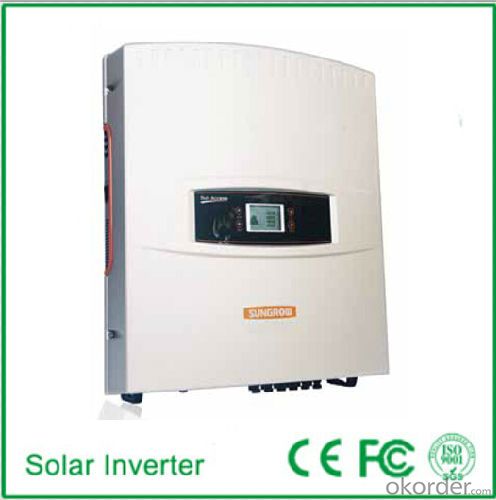
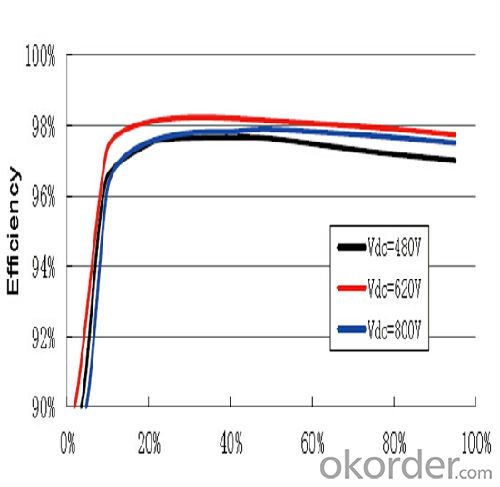
4. Photovoltaic On-Grid Connected Inverter SG20KTL Specification
Input Side Data | |
Max. PV input power | 21000W(10500W/10500W) |
Max. PV input voltage | 1000V |
Startup voltage | 300V |
Nominal input voltage | 620V |
MPP voltage range | 280~950V |
MPP voltage range for nominal power | 480~800V |
No. of MPPTs | 2 |
Max. number of PV strings per MPPT | 3 |
Max. PV input current | 42A(21A/21A) |
Max. current for input connector | 12A |
Output Side Data | |
Nominal AC output power | 20000W |
Max AC output power(PF=1) | 22200W |
Max. AC output apparent power | 22200VA |
Max. AC output current | 33A |
Nominal AC voltage | 3/N/PE, 230/400Vac |
AC voltage range | 310~480Vac |
Nominal grid frequency | 50Hz/60Hz |
Grid frequency range | 47~53Hz/57~63Hz |
THD | < 3 % (Nominal power) |
DC current injection | <0.5 %In |
Power factor | >0.99@default value at nominal power |
(adj. 0.8overexcited ~0.8underexited ) | |
Protection | |
Anti-islanding protection | Yes |
LVRT | Yes |
DC reverse connection protection | Yes |
AC short circuit protection | Yes |
Leakage current protection | Yes |
DC switch | Yes |
DC fuse | No |
Overvoltage protection | Varistors |
System Data | |
Max. efficiency | 98.00% |
Max. European efficiency | 97.30% |
Isolation method | Transformerless |
Ingress protection rating | IP65 |
Night power consumption | <1W |
Operating ambient temperature range | -25~60℃(>45℃ derating) |
Allowable relative humidity range | 0~100% |
Cooling method | Smart forced air cooling |
Max. operating altitude | 4000m (>3000m derating) |
Display | Graphic LCD |
Communication | RS485(RJ45 connector) |
DC connection type | MC4 |
AC connection type | Plug and play connector |
Certification | EN62109-1, EN62109-2, EN61000-6-2,EN61000-6-3, VDE0126-1-1, |
CEI 0-21, AS/NZS3100, AS4777.2, AS4777.3, | |
VDE-AR-N-4105, BDEW, CGC | |
Mechanical Data | |
Dimensions(W×H×D) | 648×686×246mm |
Mounting method | Wall bracket |
Weight | 55kg |
5. FAQ of Photovoltaic On-Grid Connected Inverter SG20KTL
Q1. What is the difference between inverter and solar inverter?
A1. Inverter only has AC inpput, but solar inverter both connect to AC input and solar panel, it saves more power.
Q2. What is the difference between MPPT&PWM?
A2. MPPT has higher efficiency, it can track the max power point and won't waste energy.
- Q: Are there any noise or sound considerations with a solar inverter?
- Yes, there are noise considerations with a solar inverter. While solar inverters generally produce low levels of noise, there can be some audible humming or buzzing sound generated during their operation. The noise level can vary depending on the type and model of the inverter. However, modern inverters are designed to minimize noise and are generally considered to be quiet during normal operation.
- Q: What is the efficiency of a solar inverter?
- The efficiency of a solar inverter refers to its ability to convert the direct current (DC) generated by solar panels into alternating current (AC) for use in homes or businesses. It is typically expressed as a percentage and indicates how effectively the inverter can convert the solar energy into usable electricity. Higher efficiency means less energy loss during the conversion process, resulting in more efficient utilization of the solar power.
- Q: Installation and maintenance of photovoltaic grid - connected inverter
- , any failure that affects the safety performance of the inverter must be immediately removed before turning on the inverter again.
- Q: How do you monitor the performance of a solar inverter?
- To monitor the performance of a solar inverter, several methods can be employed. Firstly, real-time monitoring systems can be installed that collect data on various parameters such as power output, voltage, current, and temperature. These systems often include data loggers or communication modules that transmit the information to a central monitoring station or cloud-based platform. Additionally, regular inspections and maintenance checks can be conducted to visually inspect the inverter for any signs of damage, loose connections, or overheating. Monitoring the inverter's efficiency over time, comparing the actual power output with the expected output based on solar irradiance and temperature, can also provide insights into its performance. Furthermore, some solar inverters come with built-in monitoring capabilities, allowing users to access performance data through a web-based interface or mobile app. This provides real-time and historical data, including energy production, system faults, and alerts, enabling users to identify and address any issues promptly. Overall, a combination of real-time monitoring systems, regular inspections, and utilizing inverter-specific monitoring features can effectively monitor the performance of a solar inverter.
- Q: How do I choose the right solar inverter for my system?
- When choosing the right solar inverter for your system, there are a few key factors to consider. First, determine the size and capacity of your solar panels to ensure compatibility. Next, consider the type of inverter you need, whether it's a string inverter, micro inverter, or power optimizer. Additionally, assess the efficiency and reliability of the inverter, as well as its warranty and after-sales support. Finally, consider your budget and any specific features you may require, such as monitoring capabilities or grid connectivity options. It's important to research and compare different models to find the one that best fits your specific solar system needs.
- Q: What is the role of a solar inverter in preventing islanding?
- The role of a solar inverter in preventing islanding is to continuously monitor the electrical grid and quickly disconnect from it if it detects any abnormalities or disruptions. This prevents the solar inverter from operating in an isolated or "islanded" mode, which could pose safety risks to utility workers and damage electrical equipment. By promptly disconnecting from the grid during such events, the solar inverter helps maintain the stability and integrity of the overall electrical system.
- Q: What is the role of a voltage regulation feature in a solar inverter?
- The role of a voltage regulation feature in a solar inverter is to ensure that the electricity generated by the solar panels is converted into a stable and consistent voltage suitable for use in homes or businesses. This feature helps to protect electrical appliances and equipment from voltage fluctuations and prevents any potential damage that could occur due to over or under voltage conditions.
- Q: How do you calculate the total power capacity for a solar inverter?
- To calculate the total power capacity for a solar inverter, you need to consider the maximum power output of the solar panels connected to it. The total power capacity of the inverter should be equal to or greater than the total maximum power output of all the solar panels combined. This ensures that the inverter can handle the maximum power generated by the solar panels and efficiently convert it into usable electricity.
- Q: Can a solar inverter be used in areas with unstable grid power?
- Yes, a solar inverter can be used in areas with unstable grid power. Solar inverters are designed to convert the DC power generated by solar panels into AC power for use in homes or businesses. In areas with unstable grid power, a solar inverter can help stabilize the electricity supply by utilizing the solar energy generated. It can operate independently or in conjunction with the grid, providing a reliable power source even during grid outages or fluctuations.
- Q: What is the role of a remote monitoring system in a solar inverter?
- The role of a remote monitoring system in a solar inverter is to allow for real-time monitoring and management of the solar power generation and inverter performance from a remote location. It provides valuable insights into the system's efficiency, troubleshooting capabilities, and helps ensure optimal performance and timely maintenance. Additionally, a remote monitoring system allows for data analysis, performance tracking, and can facilitate predictive maintenance to maximize the overall efficiency and longevity of the solar inverter system.
Send your message to us
Kaco Solar Inverter Photovoltaic On-Grid Connected Inverter SG20KTL
- Loading Port:
- China Main Port
- Payment Terms:
- TT or LC
- Min Order Qty:
- 500000 unit
- Supply Capability:
- 3000000 unit/month
OKorder Service Pledge
OKorder Financial Service
Similar products
Hot products
Hot Searches
Related keywords
